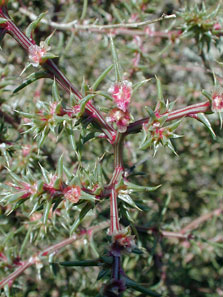RUSSIAN THISTLE
|
 |
| File Size: 100 KB |
|
|
|
Salsola tragus L.
|
| [=Salsola iberica Sennen & Pau] |
| Russell County, Kansas |
| Annual |
| Height: 6-40 inches |
| Family: Chenopodiaceae - Goosefoot Family |
| Flowering Period: July, August, September |
|
| Also Called: | | Tumbleweed, tumbling thistle, prickly russian thistle. | | Stems: | | Erect, much-branched from or near base, ridged, often red- or purple-striped, sparsely coarse-hairy to glabrous; branches many, arching upward, forming rounded bush. | | Leaves: | | Alternate, simple, sessile to clasping, thread-like to narrowly linear, .5 to 3.2 inches long, to 1/25 inch wide, reduced upwards, succulent, glabrous to pubescent; tip spiny; base broad; margins entire to minutely toothed; initial leaves long, thread-like, soft; mature leaves short, scale-like, tipped with stiff spines. | | Inflorescences: | | Spike-like, 1 to 4+ inches long, terminal on branches, densely flowered toward tip, interrupted near base; flowers solitary in upper axils of leaf-like bracts; bracts spreading, often curved back, ovate to triangular, 1/8 to 1/3 inch long, glabrous or pubescent at base, tips strongly spiny. | | Flowers: | | Perfect, sessile, inconspicuous, perianth pentagon-shaped, greenish; perianth segments 5, fused, thickened, glabrous, with prominent membranous wings at maturity; wings to 1/10 inch wide; tips blunt to weakly pointed; margins entire to scalloped; stamens 3-5, initially included, later protruding; stigmas 2-3, thread-like. | | Fruits: | | Fruit enveloped by persistent perianth segments; bladder-like, nearly circular, flattened, 1-seeded, 1/6 to 2/5 inch in diameter; seeds tiny, round, 1/16 to 1/12 inch in diameter, black, smooth, shiny. Fruit becomes reddish when ripe. | | Habitat: | | Open, disturbed sites, roadsides, overgrazed rangeland, cultivated fields, along railroads, waste areas; often in sandy soils. | | Distribution: | | Throughout Kansas | | Origin: | | Introduced. Thought to have arrived in the Great Plains in the mid 1870s with flaxseed imported from Russia. Now naturalized. | | Reproduction: | | By seed. Russian thistle is a prolific seed producer. The stems break at ground level and roll in the wind causing the seeds to fall. Thus the common name tumbleweed. The seeds require only limited moisture to germinate. | | Toxicity: | | Accumulates nitrates. Toxic to livestock. If consumed in excess, it can lead to diarrhea, weakness, labored breathing, and even death. | | Forage Value: | | Fair when young for sheep and cattle but no value when mature. | | Uses: | | Native Americans in the Southwest applied chewed plants to insect stings, steeped ashes from the plant and used the liquid internally and externally to treat influenza and smallpox. The sprouts were boiled and eaten with butter or mutton fat, young fresh sprouts were used in salads, and the seeds were roasted for food. Provides cover for pheasants. Songbirds and small mammals eat the seeds and foliage. | | Comments: | | Russian thistle is a common and troublesome weed. It is drought resistant and takes up a great deal of soil moisture. Can be controlled by tillage because the root system is shallow. During drought years in the 1930s, Russian thistle helped stabilize the soil from blowing and the young plants were used for hay. When many of the tumbling bushes become lodged in fences they can cause the fences to break. The plant becomes reddish with maturity. From Latin salsus "salty", in reference to the habitats where it sometimes grows. |
|
| Russian thistle |  | | 148 KB | | Russell County, Kansas |
| | Russian thistle inflorescences |  | | 104 KB | | Russell County, Kansas |
| | Russian thistle branches |  | | 152 KB | | Russell County, Kansas |
| | Russian thistle |  | | 48 KB | | Russell County, Kansas |
| | Russian thistle mature leaves and bracts |  | | 80 KB | | Russell County, Kansas |
| | Russian thistle inflorescences |  | | 132 KB | | Russell County, Kansas |
| | | | |
|
|
|
|
|
|